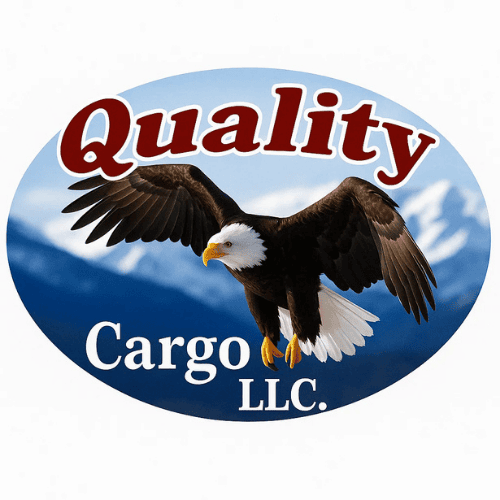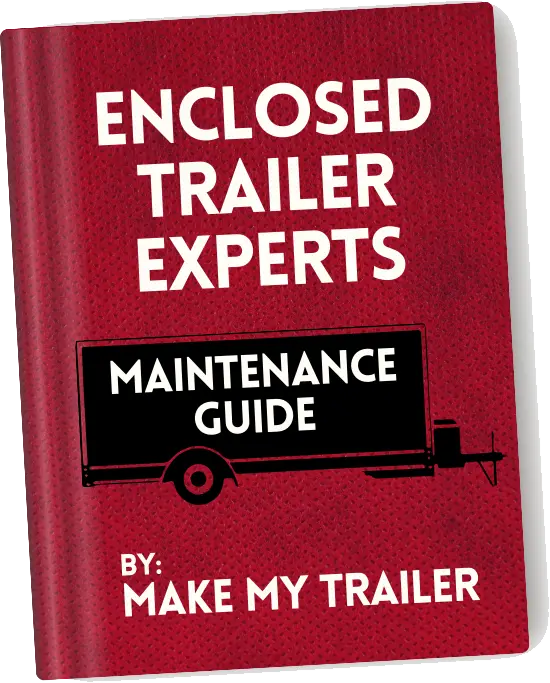Everything you need to know about the
6x12 Single Axle - Quality Cargo
- 6×12 Single
- Maintenance & More
6x12 Single Axle - Quality Cargo
1. Technical Features Table
→ → →
| Standard Features | Quality |
| PRICE | $3,853.00 |
| EXTERIOR METAL | .024 metal exterior Semi-Screwless exterior |
| AXLES | 2990 lb Spring axle with 4" drop and EZ Lube Hubs |
| V-NOSE | V-Nose with vertical ATP trim |
| DOME LIGHT | 12V Dome light with switch |
| WALLS/CEILING TUBING | 1"x1½" steel tube in walls and ceiling |
| FLOOR TUBING | 2x3" Steel Tube Main Rails |
| FLOOR CROSS-MEMBERS | Floor crossmembers 16" O.C. |
| ROOF CROSS-MEMBERS | Roof members 24" O.C. |
| WALL CROSS-MEMBERS | Wall members 16" O.C. |
| LIGHTS | LED Strip tail lights |
| INTERIOR HEGHT | 75" (6'3") Interior height |
| REAR DOOR | Double rear door w/bar lock or ramp |
| PLUG / COUPLER (BALL) | 4-way Bargman plug 2" coupler |
| SIDE DOOR | 32" RV style side door with flush lock |
| FENDERS | Aluminum Fender w/Lights |
| TIRES | 15" Tires |
| RIMS/WHEELS | Silver Mod Wheels |
| ROOF MATERIAL | Galvalume roof |
| WALL MATERIAL | 3/8" Plywood Walls |
| FLOOR MATERIAL | 3/4" Plywood Floor |
| EMPTY WEIGHT | 1300 lbs |
| LOAD CAPACITY | 1690 lbs |
| GVWR | 2990 lbs |
| TONGUE WEIGHT | 180 lbs |
2. Technical FAQ

Overall Length: 15’6″ / 186 in (Breakdown: 12′ on the Box + 3’6″ on the Tongue) 20″ on the Vnose
Overall Width: 7’6″ / 90 in (Breakdown: 6′ on the Box + 9″ on each Fender)
Overall Height: 7’7″ / 91 in (Breakdown: 6’3″ on the Box + 16″ from the ground to the box)
Overall Height (Diamond): 7’10” / 94 in (Breakdown: 6’6″ on the Box + 16″from the ground to the box)
Overall Length: 11’9″ Box (Breakdown: Subtract 3″ which counts for rear door & framing) plus 20″ on the Vnose
Overall Width: 5’8″ (Breakdown: Subtract 4″ (2″ on each side) which counts for plywood & framing)
Overall Height: 6’3″
Overall Height (Diamond): 6’6″
Width: 62″ (Breakdown: Subtract 10″ (5 on each side) which counts for plywood & framing)
Height: 69″ (Breakdown: Subtract 6″ which counts for plywood & framing)
Height (Diamond): 72″ (Breakdown: Subtract 6″ which counts for plywood & framing)
No it doesn’t but they’re available as a custom option.
Side Note: If the combined weight of the trailer and its load approaches or exceeds 3,000 pounds, many jurisdictions require brakes on the trailer. However, a 4×6 enclosed trailer, given its size, is unlikely to reach this weight limit when fully loaded, as they typically have a lower payload capacity.
Safety Considerations
Driving Conditions: If you plan to tow your trailer in hilly or mountainous areas, or if you’ll be driving in a lot of stop-and-go traffic, having electric brakes can significantly improve safety by reducing stopping distances and improving vehicle control.
Emergency Handling: Electric brakes can offer better control in emergency braking situations, reducing the risk of accidents.
Wear on Vehicle Brakes: Using a trailer with its own braking system can reduce wear and tear on your vehicle’s brakes, especially important for frequent towing or heavy loads.
4-way flat plug
5×4.5 (5 Lug)
6 Ply
Screws are 4′ apart instead of being every 2′
It’s an asphalt undercoating paint
We developed a section exclusively for Custom Options where we show sample photos and explain most popular options:
Click Here for More Information.
Here are examples of some of the most popular Custom Options:
– Blackout Package
– Electrical Package
– Insulation Package
– Rubber Flooring
– Etracks
– D-rings
– Windows
– Extended Tongue
– Extra Height
– Ladder Racks
– Finished Interior (Metal/Vinyl)
– Air Conditioner
– Lighting Options
– Axle Upgrades
– Concession Window
– Special Door Options
– Cabinets
– Barn Doors
3. Sample Photos
4. Sample Video
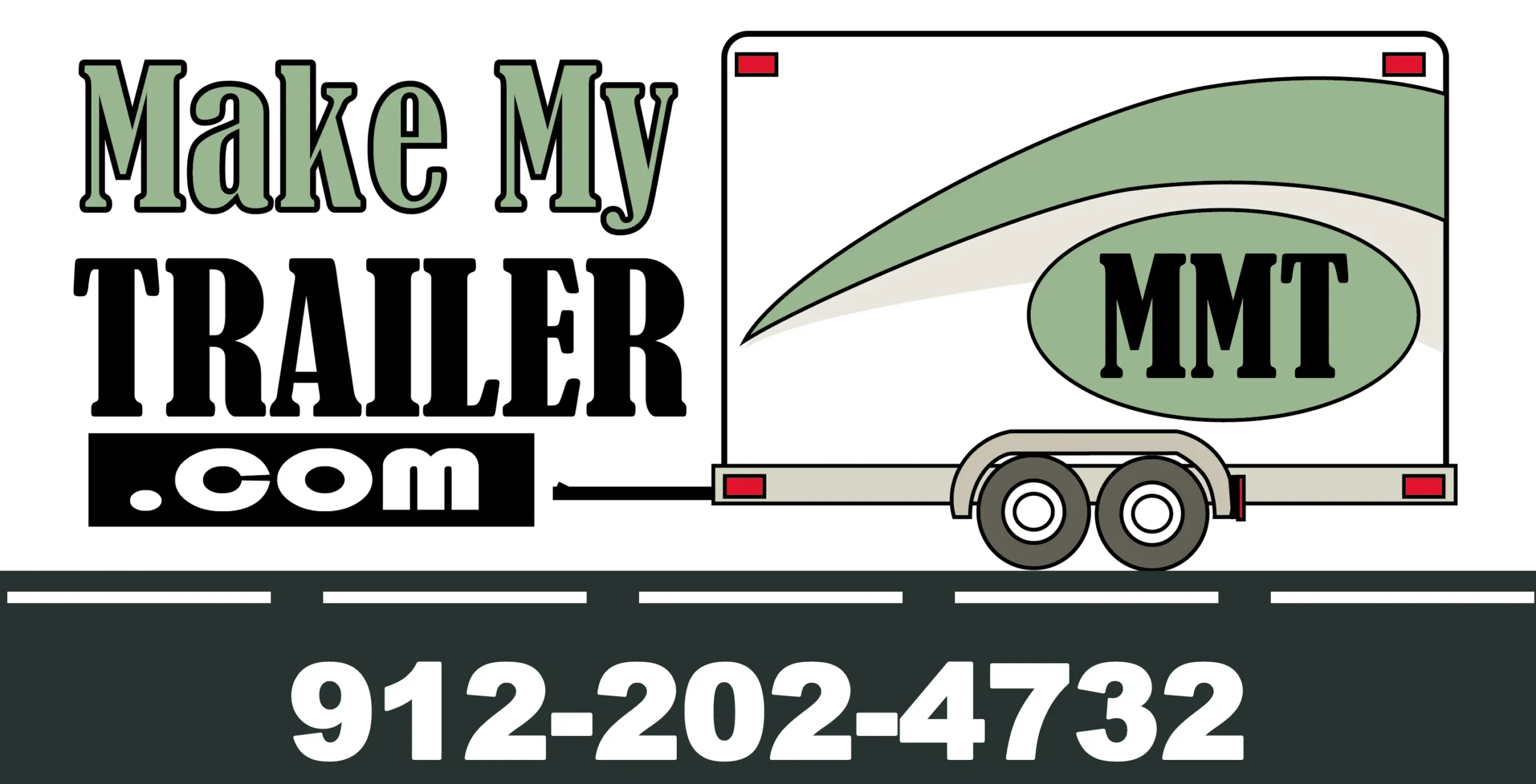
5. Sample Colors (Click to enlarge)
6. Purchase FAQ
Click the link below for Financing Options:
https://makemytrailer.com/enclosed-trailer-financing-services/
Click the link below for Delivery Options:
https://makemytrailer.com/delivery/
30 Day Temporary Tag, Certificate of Origin and obviously your Title so you can register your brand new trailer
Yes they are and also the reason why your trailer pick up is directly at the Factory.
We do not charge any taxes, that’s something that you pay when you register the trailer
Yes, as soon as your trailer is ready we can provide your with your VIN number.
1) Credit or Debit Card (over the phone or invoice sent to your email)
2) Mail a Cashier’s Check
3) Wire Transfer
Once your deposit is confirmed we’ll send you an email just make everything official and after 24 hours (timeframe we provide in case of any changes) we will send your order to our production team so they can start working on your future top notch trailer
It depends on 2 factors: The season and your Order so make sure to ask our awesome sales team for a more accurate completion timeframe but on average you might be looking between 2 to 4 weeks on standard order and about 3 to 5 weeks for orders with custom options.
Note: We do make exceptions so make sure to ask our sales team
We don’t usually provide any updates during the building process but we can definitely ask our production team how things are going but as soon as your trailer is ready, we will send you the completion email along with the instructions so you can start your pick up arrangements
By clicking Buy Now, you will be redirected to our secure PayPal checkout page. A deposit is required to reserve the standard version of this trailer size. The remaining balance, including any selected options or upgrades (such as A/C or insulation), will be due at pickup or delivery. Final price may vary depending on manufacturer and features. Please contact us to confirm details before completing your order.
7. Get a Quote
Have you recently invested in an enclosed cargo trailer, or are you looking to maximize the lifespan and efficiency of your current one? Our comprehensive PDF guide is your ultimate companion to mastering the art of trailer maintenance!
- Step-by-step instructions on pre-use checks to ensure safety and readiness for the road.
- Expert advice on periodic maintenance routines to keep your trailer in peak condition.
- DIY tips for interior and exterior care, from flooring maintenance to rust prevention.
- Winterizing strategies that protect your investment through the coldest months.
- Essential insights into tire care, brake maintenance, and the importance of proper ventilation.
- Bonus content: Safety equipment checklist, emergency preparedness, and much more!
Safeguard Your Investment:
10 Smart Ways to Prevent Trailer Theft!

The Ultimate Guide to Finding a Quality 6x12 Single Axle Cargo Trailer
In the world of hauling, finding the perfect balance of size, maneuverability, and capacity is the ultimate goal. For many, that sweet spot is the 6×12 single axle cargo trailer. It’s a versatile workhorse, small enough to navigate tight spaces yet large enough to handle significant loads for small businesses, weekend projects, and cross-country moves. This guide is designed to transform you from a prospective buyer into an informed expert, equipping you with the knowledge to dissect specifications, identify true quality, and select an enclosed trailer that will serve you reliably for years to come. We will explore everything from the foundational structure to the nuances of towing safety, ensuring your final decision is the right one.
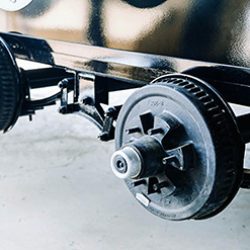
Introduction: Why a 6×12 Single Axle Cargo Trailer Might Be Your Perfect Partner
The Versatility of the 6×12 Single Axle Enclosed Trailer
The 6×12 single axle enclosed trailer occupies a unique position in the market. Its dimensions offer approximately 72 square feet of floor space, making it ideal for hauling everything from landscaping equipment and construction tools to furniture and ATVs. The enclosed design provides critical protection from weather and theft, turning it into a secure, mobile storage unit. Unlike larger tandem axle models, its single axle configuration makes it lighter, more maneuverable in tight spots, and towable by a wider range of SUVs and trucks.
Who This Guide Is For: From DIY Enthusiasts to Small Businesses
This guide serves a broad audience. For the small business owner—be it a contractor, a mobile detailer, or a delivery service—this trailer is a rolling billboard and an essential tool. For the DIY enthusiast, it’s the key to bringing home lumber for a deck project or moving a child into their first apartment. It’s also for the outdoor adventurer who needs a secure way to transport motorcycles, kayaks, or camping gear. If you need more capacity than a pickup bed but don’t require a massive tandem axle rig, you’ve come to the right place.
Understanding the 6×12 Single Axle Cargo Trailer: Core Definitions and Benefits
What Defines a 6×12 Single Axle Trailer?
At its core, a 6×12 single axle trailer is defined by its dimensions and running gear. The “6×12” refers to the interior box dimensions: approximately 6 feet wide and 12 feet long. The “single axle” designation means it has one axle with a wheel on each side. This simple configuration is key to its performance and cost-effectiveness. Most trailers in this class feature a Gross Vehicle Weight Rating (GVWR) of 2,990 lbs, a threshold that often exempts them from requiring electric brakes in many jurisdictions, although this can vary.
Key Advantages of the Single Axle Configuration
The primary benefits of the single axle design are maneuverability, lower cost, and reduced maintenance. With only two tires on the ground and no pivot point between axles, backing up and navigating tight corners is significantly easier than with a tandem trailer. The initial purchase price is lower due to fewer components (axle, suspension, wheels, brakes). Similarly, long-term maintenance costs are reduced, with only two tires to replace and two sets of wheel bearings to service.
Common Use Cases: Why This Size and Type Excels
The 6×12 single axle trailer shines in a variety of applications. Landscapers use it for mowers and tools, carpenters for saws and materials, and mobile service providers for their entire operation. It’s perfectly sized for moving the contents of a studio apartment, hauling a four-wheeler to the trails, or transporting band equipment to a gig. Its versatility makes it a practical investment that can adapt to both professional and personal needs.
Deciphering Quality: Essential Features and Specifications for Your 6×12
The Foundation: Axle and Gross Vehicle Weight Rating (GVWR)
The foundation of any trailer is its axle. A quality 6×12 model typically uses a 3,500 lb rated leaf spring axle, often de-rated to a 2,990 lb GVWR for regulatory reasons. This GVWR represents the maximum total weight of the trailer and its contents. Understanding your Payload Capacity is crucial: subtract the trailer’s empty weight (e.g., 1,200 lbs) from the GVWR (2,990 lbs) to find what you can safely carry (1,790 lbs). Always confirm these numbers to match your towing needs.
Structural Integrity: Frame, Walls, and Roof
A trailer’s longevity is determined by its skeleton. Look for a main frame constructed from rectangular Steel Tube Main members, as this is stronger and more resistant to twisting than C-channel or angle iron. Wall studs and Roof Members spacing is also critical; 16-inch on-center spacing provides superior rigidity compared to the more common 24-inch spacing. This robust construction prevents flexing and ensures the exterior panels remain secure over rough roads.
Exterior Durability and Design Features
The exterior skin protects your cargo. While standard .024″ aluminum is common, upgrading to a thicker gauge or a bonded material like Polycore can significantly improve durability and appearance. A V-NOSE design is a popular and practical feature. It improves aerodynamics for better fuel economy during towing and adds valuable interior storage space at the front of the trailer. Look for a stone guard on the V-nose to protect against road debris.
Interior Functionality and Cargo Management
Inside, the flooring and walls are paramount. High-quality Plywood walls, typically 3/8-inch thick, provide a sturdy surface for mounting shelves or tie-down systems. The floor should be at least 3/4-inch thick PLYWOOD FLOORS to support heavy, concentrated loads. The standard INTERIOR HEIGHT is often around 6 feet 3 inches, which is adequate for most people to stand comfortably. If you are taller or carry bulky items, consider options for additional height.
Doors, Wheels, and Lighting for Practicality and Safety
Functionality hinges on access and safety. A spring-assisted Ramp door is essential for rolling equipment in and out, while a Side Door with an RV-style latch offers convenient walk-in access without opening the entire rear. Standard 15-inch steel wheels with radial tires are the norm and offer good reliability. Finally, ensure all lighting is LED. LED lights are brighter, last longer, and draw less power than traditional incandescent bulbs, enhancing your visibility and safety on the road.
Beyond the Spec Sheet: What Truly Makes a Trailer “Quality”?
The Art of Craftsmanship and Materials: More Than Just “Quality Cargo”
While a brand name like QUALITY CARGO can be an indicator of a certain standard, true quality lies in the execution. Look closely at the welds on the frame; they should be clean, consistent, and complete, not spotty or sloppy. Check how the wiring is run—is it protected in conduit or simply stapled to the frame’s underside? Are the edges of the aluminum siding and trim sealed properly to prevent water intrusion? These details separate a premium trailer from a budget build.
Manufacturer Reputation and Warranty Programs
A manufacturer’s confidence in their product is reflected in their warranty. A solid multi-year structural warranty is a good sign. Research the manufacturer’s reputation online through forums and reviews. Do they stand behind their product when issues arise? A reputable dealer will also play a role here, as they are your first line of support for warranty claims and service. A strong manufacturer and dealer partnership is a key component of a good ownership experience.
Attention to Detail: Small Features That Indicate Superior Build
Superior quality often reveals itself in the small things. Does the trailer have greaseable hinges on the ramp door to ensure smooth operation? Is the underside of the plywood floor undercoated to protect against moisture? Are safety chains properly rated and securely attached to the frame? Does the Coupler mechanism feel robust and engage securely? These minor features add up to a more reliable, durable, and user-friendly trailer.
Safety First: Towing, Driving, and Emergency Considerations
Matching Your Trailer to Your Tow Vehicle: Understanding Payload Capacity and Towing Limits
Safety begins before you ever hit the road. Your tow vehicle must be rated to handle the trailer’s GVWR. Check your vehicle’s owner’s manual for its maximum towing capacity and tongue weight limit. Exceeding these limits can lead to dangerous handling, brake failure, and damage to your vehicle’s transmission and frame. Proper weight distribution inside the cargo trailer is also critical, with about 60% of the weight placed forward of the axle.
Pre-Trip Safety Checks: Coupler Connection, Safety Chains, and Lighting
Create a pre-trip checklist and use it every time. Ensure the Coupler is securely latched onto the hitch ball and the safety pin is in place. Crisscross the safety chains under the tongue and attach them to the tow vehicle’s frame. Connect the wiring harness and check that all lights—running lights, brake lights, and turn signals—are functioning correctly. Finally, inspect the tires for proper inflation and any visible signs of damage or wear.
On the Road: Driving Conditions, Vehicle Control, and Emergency Braking Techniques
Towing changes your vehicle’s driving dynamics. Allow for longer stopping distances and greater turning radii. Be mindful of crosswinds, which can have a more significant effect on a large, enclosed trailer. When braking, apply smooth, steady pressure. In an emergency, try to brake in a straight line to maintain control. Avoid sudden steering maneuvers that could induce trailer sway, a dangerous side-to-side oscillation that can lead to a loss of control.
The Critical Role of Trailer Brakes (e.g., electric brakes)
While many 2,990 lb GVWR single axle trailers do not come standard with brakes, they are a vital safety feature. If you regularly haul heavy loads or travel in hilly terrain, adding electric brakes is a wise investment. They significantly reduce the stopping distance and take a tremendous amount of strain off the tow vehicle’s brakes. A trailer equipped with brakes requires a brake controller to be installed in your tow vehicle.
The Buying Journey: How to Find Your Ideal 6×12 Single Axle Cargo Trailer
Defining Your Specific Needs and Budget: Custom Trailer vs. Standard Options
Begin by clearly defining your primary use case. Will you need extra INTERIOR HEIGHT? Do you require specialized tie-downs like E-track? Answering these questions will help you decide between a standard, in-stock trailer and ordering a custom build. Standard options offer the best value, but a custom trailer ensures you get every feature you need. Establish a clear budget that includes the trailer price, taxes, registration fees, and any immediate upgrades.
Where to Look: Dealerships, Online Marketplaces, and Private Sellers
Reputable dealerships are often the best place to start. They offer new trailers with full warranties and can handle financing and registration. You can find dealers in various locations, from Evans City, PA, to Irwin, PA, or Pearson, GA. Online marketplaces can offer a wider selection, but require more due diligence. Private sellers may offer lower prices, but purchases are typically “as-is” with no warranty, demanding a thorough inspection.
What to Ask Your Dealer: Trailer Specifications, UNIT SPECS, and Custom Options
When you find a potential trailer, ask for the detailed UNIT SPECS. Go beyond the basics and inquire about the frame’s steel gauge, the type of axle suspension, and the plywood grade. Ask about the warranty details and what they cover. If you’re considering customizations, discuss the available options and lead times. A knowledgeable salesperson should be able to answer these questions confidently. If they can’t, it might be a red flag.
The Pre-Purchase Inspection: What to Examine Closely
Whether buying new or used, a hands-on inspection is non-negotiable. Walk around the entire trailer, looking for dents or panel damage. Inspect the frame welds and look for any signs of rust. Operate the ramp and side doors to ensure they function smoothly. Check the floor for soft spots. Look underneath at the axle, springs, and wiring. Spin the tires to check for smooth bearing operation. Don’t be afraid to get dirty; a thorough inspection can save you from costly future repairs.
Understanding Trailer Price and Potential Upgrades
The price of a 6×12 single axle cargo trailer can vary based on brand, features, and build quality. A basic model might be your entry point, but consider the cost of essential upgrades. Adding brakes, upgrading to radial tires, or opting for a thicker exterior skin will increase the price but can add significant value and safety. Factor these potential costs into your initial budget to avoid surprises.
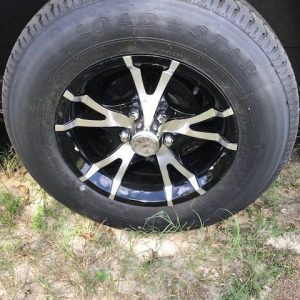
Conclusion
Choosing the right 6×12 single axle cargo trailer is an investment in capability and efficiency. The journey begins not on the dealer’s lot, but with a clear understanding of your own needs. By prioritizing structural integrity—a robust Steel Tube Main frame, proper crossmember spacing, and quality Plywood floors and walls—you lay the groundwork for a long-lasting tool. Pay close attention to the GVWR and Payload Capacity to ensure the trailer is a safe match for your vehicle and your cargo. Inspect the craftsmanship, from the quality of the welds to the sealing of the roof, as these details separate a reliable workhorse from a future problem.
Your next steps are clear: define your non-negotiable features, set a realistic budget, and begin your search with reputable dealers. When you find a promising trailer, use the knowledge from this guide to perform a meticulous pre-purchase inspection. Ask pointed questions about the UNIT SPECS and warranty. By being an educated buyer, you can confidently select a quality cargo trailer that will not only meet your demands but exceed your expectations for years of reliable service.
Next Up>>> 6×14 single axle quality cargo



